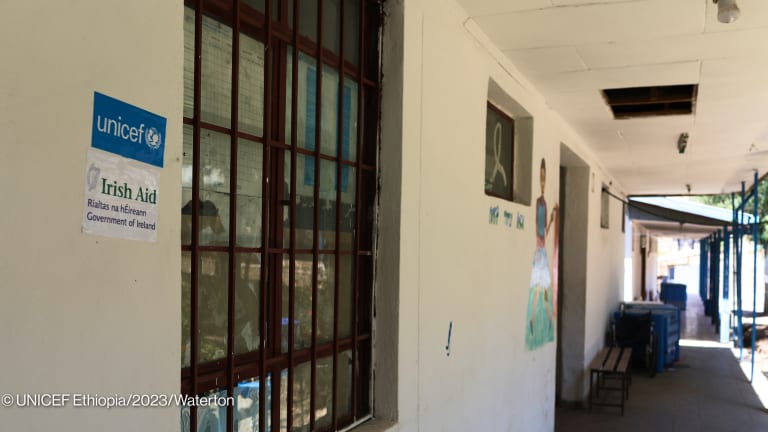Aid to water supply and sanitation: Where the money is going
How much aid goes to water supply and sanitation? We take a look at the numbers.
The U.N. General Assembly declared March 22 as World Water Day in 1993, but it was only in 2010 when, through a resolution that rallied donors and international organizations to help developing countries gain access to safe and affordable drinking water and sanitation, the organization recognized access to water supply and sanitation as a human right. Just a year before water supply and sanitation was officially named a human right by the United Nations, aid to the sector peaked at $6.8 billion. Disbursements dropped to $5.4 billion in 2010 and $5.1 billion in 2011, but rebounded to $6.3 billion in 2012. In 2013, the latest year for which official development assistance figures are available from the Organization for Economic Cooperation and Development, water supply and sanitation assistance was at $5.7 billion — slightly higher than 2010 and 2011 levels. While aid to the water supply and sanitation sector has not been a drop in the bucket, commitments have far exceeded disbursements. For example, in 2013, donors committed $9.7 billion to the sector — nearly $4 billion more than the actual disbursed amount for water supply and sanitation that year. Below, we take a closer look at ODA to the water sector in 2013. Water supply comprised the bulk of aid commitments OECD breaks down aid to the water supply and sanitation sector into 11 areas: water resources policy and administrative management, water resources protection, large water supply and sanitation systems, large water supply systems, large sanitation systems, basic drinking water supply and basic sanitation, basic drinking water supply, basic sanitation, river development, waste management and disposal, and education and training in water supply and sanitation. In 2013, a huge chunk of water commitments — $2.1 billion, or 22 percent — went to potable water treatment plants, water supply pumping stations and large-scale conveyance and distribution systems. The smallest share of aid commitments went to education and training in water supply and sanitation, which received $68 million in commitments, or a mere 0.71 percent of total committed assistance to the sector that year. Traditional donors dominate — but emerging donors are catching up Japan, the World Bank, Germany, the European Union and the United States are the top five donors to water supply and sanitation in 2013. The United Arab Emirates and South Korea, however, gave at least $370 million to the sector and even eclipsed France and the African Development Bank in terms of disbursements that year. The Bill & Melinda Gates Foundation, while not among the top donors to the sector, still disbursed a significant $69 million in 2013. Early this year, the foundation garnered attention for its work on water supply and sanitation when Bill Gates drank water processed by the Omniprocessor, a compact waste treatment plant developed by Janicki Bionergy that can turn sewage into high-grade drinking water. Lower-middle-income economies are the largest recipients Several of the top recipients of water assistance commitments — India, Morocco, Vietnam, Zambia, Egypt and Sri Lanka — are lower-middle-income economies. Bangladesh, Mozambique and Mali are the few low-income countries among the largest recipients. Tunisia, which has achieved the highest access rates to water and sanitation in the Middle East and North Africa, is the sole upper-middle-income economy on the list. In India, where water supply and sanitation remains a persistent problem, the World Bank ($539 million) and Japan ($187.2 million) had the most commitments to the sector. Meanwhile, in Zambia, where according to Water & Sanitation for the Urban Poor as much as 90 percent of the capital’s population does not have access to adequate sanitation facilities, the United States ($295.7 million) and the World Bank ($50 million) had the largest commitments. Check out more funding trends analyses online, and subscribe to Money Matters to receive the latest contract award and shortlist announcements, and procurement and fundraising news.
The U.N. General Assembly declared March 22 as World Water Day in 1993, but it was only in 2010 when, through a resolution that rallied donors and international organizations to help developing countries gain access to safe and affordable drinking water and sanitation, the organization recognized access to water supply and sanitation as a human right.
Just a year before water supply and sanitation was officially named a human right by the United Nations, aid to the sector peaked at $6.8 billion. Disbursements dropped to $5.4 billion in 2010 and $5.1 billion in 2011, but rebounded to $6.3 billion in 2012.
In 2013, the latest year for which official development assistance figures are available from the Organization for Economic Cooperation and Development, water supply and sanitation assistance was at $5.7 billion — slightly higher than 2010 and 2011 levels.
This story is forDevex Promembers
Unlock this story now with a 15-day free trial of Devex Pro.
With a Devex Pro subscription you'll get access to deeper analysis and exclusive insights from our reporters and analysts.
Start my free trialRequest a group subscription Printing articles to share with others is a breach of our terms and conditions and copyright policy. Please use the sharing options on the left side of the article. Devex Pro members may share up to 10 articles per month using the Pro share tool ( ).
Anna Patricia Valerio is a former Manila-based development analyst who focused on writing innovative, in-the-know content for senior executives in the international development community. Before joining Devex, Patricia wrote and edited business, technology and health stories for BusinessWorld, a Manila-based business newspaper.








